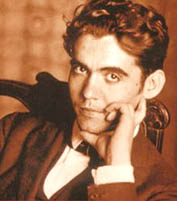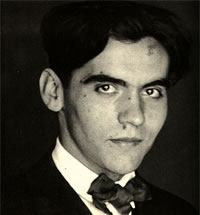
Era hijo del hacendado Federico García Rodríguez y de la maestra Vicenta Lorca.
De salud enfermiza y mal estudiante, se graduó luego de sortear varios obstáculos, en la Universidad de Granada, como abogado. Estudió música (piano) pero por influencia de su madre y de Don Fernando de los Ríos, comenzó a inclinarse por la poesía. Su primer artículo, data de 1917, y fue con motivo del aniversario de José Zorrilla.
Su obra muestra la influencia de autores como Benito Pérez Galdós, Miguel de Unamuno, José Ortega y Gasset, Lope de Vega, Juan Ramón Jiménez, Antonio y Manuel Machado, entre otros.
Su padre lo ayudó económicamente para que en 1918 apareciera su primer libro “Impresiones y Paisajes”. En teatro, estrenó en 1920 “El maleficio de la mariposa”. En 1921 “Libro de poemas” (Antología) y en 1923 “La niña que riega la albahaca y el príncipe preguntón” (Comedia de títeres). Publicó “Canciones” en 1927, y al año siguiente surgió la Revista Literaria “Gallo” de la cual solo dos números fueron editados. Aparece ese mismo año el libro “Primer romancero gitano”, donde expresa con grandes metáforas y abundancia de símbolos (La luna, los colores, los caballos, los peces) sentimientos sobre el amor y la muerte en una mítica Andalucía.
En 1929 viajó a Nueva York, donde publicó “Poeta en Nueva York” Un año más tarde se dirigió a La Habana, donde escribió “Así pasen cinco años” y “El público”. Ese mismo año regresó a España donde se estrenaba “La zapatera prodigiosa”, su farsa popular, que enfrenta realidad e imaginación.
Su producción siguió creciendo: “Bodas de sangre”, “Yerma” y “Doña Rosita la soltera” fueron escritas con el gran apoyo moral y financiero de su amigo Fernando de los Ríos, que se desempeñaba como Ministro de Instrucción Pública. Fue nombrado Director del teatro universitario La Barraca, y desde allí realizó una amplia labor de divulgación por toda España.
Viajó a Argentina y Uruguay entre 1933 y 1934, con gran éxito. En 1935, escribió “Llanto por Ignacio Sánchez Mejías”, en la línea del neopopulismo.
Luego, sobrevinieron, en 1936, “Diván del Tamarit” y “Sonetos del amor oscuro”. En “La casa de Bernarda Alba”, afronta el drama de la represión de lamujer y la intolerancia.

En general, su obra, que puede agruparse en farsas, comedias, tragedias y dramas, se inscribe en el dramatismo y el realismo político, inspirado en temas como el amor, la esterilidad, la infancia y la muerte.
Con una gran capacidad de síntesis, armoniza formas, tonalidades y símbolos, como por ejemplo, la luna, que muchas veces representa la muerte, y en otras, la fecundidad, la esterilidad o la belleza. Sus metáforas relacionan elementos opuestos de la realidad y transmiten efectos sensoriales entremezclados.
La tradición está muy presente en su obra, a través de la música y los cantos tradicionales.
Tuvo la influencia del drama modernista, del teatro de Lope de Vega y de Calderón de la Barca.
Falleció fusilado en Granada, víctima del fascismo, durante la Guerra Civil española, a pesar de no haberse afiliado a ninguna fracción política, aproximadamente el 19 de agosto de 1936.
Luego de su muerte, se publicaron “Primeras canciones”, “Amor de Don Perlinplín con Belisa en su jardín” y “Odas y Suites”.
-----------------------
He was born on June 5, 1898, in the town of Fuente Vaqueros, Granada (Spain). Federico García Lorca Squire was the son of Federico García Rodríguez and teacher Vicenta Lorca. Of ill health and poor student, then graduated to circumvent various obstacles, the University of Granada, as a lawyer. He studied music (piano), but the influence of his mother and Don Fernando de los Rios, began to lean towards poetry. His first article, dates from 1917, and was to mark the anniversary of José Zorrilla.
His work shows the influence of artists such as Benito Pérez Galdós, Miguel de Unamuno, José Ortega y Gasset, Lope de Vega, Juan Ramón Jiménez, Antonio and Manuel Machado, among others.
His father helped him financially so that in 1918 appeared his first book "Impressions and Landscapes". In theater, opened in 1920, "The Curse of the butterfly." In 1921 "Book of Poems" (Anthology) and in 1923 "The girl watering the basil and inquisitive prince" (Comedy of puppets). Published "Songs" in 1927, and the following year came the Literary Magazine "Gallo" of which only two numbers were released. It appears that same year the book "First Gypsy Ballads, which he expresses with great abundance of metaphors and symbols (The moon, the colors, horses, fish) feelings about love and death in a mythical Andalusia.
In 1929 he traveled to New York, where he published "Poet in New York" A year later he went to Havana, where he wrote "Just spend five years" and "public." That same year he returned to Spain where he premiered "The Shoemaker's Prodigious Wife," his popular farce, facing reality and imagination.
Its production continued to grow, "Blood Wedding", "Yerma" and "Dona Rosita the Spinster" was written with the great moral and financial support of his friend Fernando de los Rios, who served as Minister of Public Instruction. Appointed Director of University Theatre La Barraca, and from there conducted an extensive outreach throughout Spain.
He traveled to Argentina and Uruguay between 1933 and 1934, with great success. In 1935, he wrote "Lament for Ignacio Sánchez Mejías", in line with the new populism. Then ensued, in 1936, "Divan del Tamarit" and "Sonnets of Dark Love." In "The House of Bernarda Alba", faces the drama of repression and intolerance lamujer.
Federico García Lorca
In general, his work, which can be grouped into farces, comedies, tragedies and dramas, is part of the drama and political realism, inspired by themes of love, infertility, childhood and death. With a great ability to synthesize, harmonize forms, colors and symbols, for example, the moon, which often represents death, and elsewhere, fertility, infertility or beauty. Related metaphors opposing elements of reality and transmit sensory effects intermingled. The tradition is very present in his work, through music and traditional songs.
Had the influence of modernist drama of Lope de Vega and Calderon de la Barca.
Died shot in Granada, a victim of fascism during the Spanish Civil War, despite having no affiliated with any political faction, about August 19, 1936.
After his death, he published "First Songs", "Amor de Don Perlinplín and Belisa in the Garden" and "Odes and Suites."
His work shows the influence of artists such as Benito Pérez Galdós, Miguel de Unamuno, José Ortega y Gasset, Lope de Vega, Juan Ramón Jiménez, Antonio and Manuel Machado, among others.
His father helped him financially so that in 1918 appeared his first book "Impressions and Landscapes". In theater, opened in 1920, "The Curse of the butterfly." In 1921 "Book of Poems" (Anthology) and in 1923 "The girl watering the basil and inquisitive prince" (Comedy of puppets). Published "Songs" in 1927, and the following year came the Literary Magazine "Gallo" of which only two numbers were released. It appears that same year the book "First Gypsy Ballads, which he expresses with great abundance of metaphors and symbols (The moon, the colors, horses, fish) feelings about love and death in a mythical Andalusia.
In 1929 he traveled to New York, where he published "Poet in New York" A year later he went to Havana, where he wrote "Just spend five years" and "public." That same year he returned to Spain where he premiered "The Shoemaker's Prodigious Wife," his popular farce, facing reality and imagination.
Its production continued to grow, "Blood Wedding", "Yerma" and "Dona Rosita the Spinster" was written with the great moral and financial support of his friend Fernando de los Rios, who served as Minister of Public Instruction. Appointed Director of University Theatre La Barraca, and from there conducted an extensive outreach throughout Spain.
He traveled to Argentina and Uruguay between 1933 and 1934, with great success. In 1935, he wrote "Lament for Ignacio Sánchez Mejías", in line with the new populism. Then ensued, in 1936, "Divan del Tamarit" and "Sonnets of Dark Love." In "The House of Bernarda Alba", faces the drama of repression and intolerance lamujer.
Federico García Lorca
In general, his work, which can be grouped into farces, comedies, tragedies and dramas, is part of the drama and political realism, inspired by themes of love, infertility, childhood and death. With a great ability to synthesize, harmonize forms, colors and symbols, for example, the moon, which often represents death, and elsewhere, fertility, infertility or beauty. Related metaphors opposing elements of reality and transmit sensory effects intermingled. The tradition is very present in his work, through music and traditional songs.
Had the influence of modernist drama of Lope de Vega and Calderon de la Barca.
Died shot in Granada, a victim of fascism during the Spanish Civil War, despite having no affiliated with any political faction, about August 19, 1936.
After his death, he published "First Songs", "Amor de Don Perlinplín and Belisa in the Garden" and "Odes and Suites."
-----------------
LOS CUATRO MULEROS
1
De los cuatro muleros
que van al campo,
el de la mula torda,
moreno y alto.
que van al campo,
el de la mula torda,
moreno y alto.
2
De los cuatro muleros
que van al agua,
el de la mula torda
me roba el alma.
que van al agua,
el de la mula torda
me roba el alma.
3
De los cuatro muleros
que van al río,
el de la mula torda
es mi marío.
que van al río,
el de la mula torda
es mi marío.
4
¿A qué buscas la lumbre
la calle arriba,
si de tu cara sale
la brasa viva?
la calle arriba,
si de tu cara sale
la brasa viva?
----------------
The four mule drivers
1
Of the four mules
going to the field
that of the dappled mule,
dark and tall.
2
Of the four mules
going to water
that of the dappled mule
steals my soul.
3
Of the four mules
going to the river,
that of the dappled mule
is my husband.
4
What do you look for the fire
up the street,
if your face out
grilled alive?
1
Of the four mules
going to the field
that of the dappled mule,
dark and tall.
2
Of the four mules
going to water
that of the dappled mule
steals my soul.
3
Of the four mules
going to the river,
that of the dappled mule
is my husband.
4
What do you look for the fire
up the street,
if your face out
grilled alive?

No hay comentarios:
Publicar un comentario